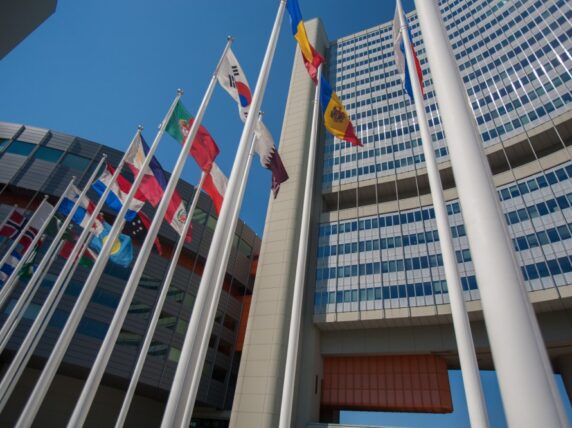Stats on international development: how did the UK spend aid in 2018?
The Department for International Development (DFID) has released the annual Statistics on International Development report, which provides final statistics on how much Official Development Assistance (ODA) the UK provided in 2018.
The report includes UK ODA as a proportion of GNI (the ODA:GNI ratio), which has again met the 0.7% spending target.
In 2018, total UK ODA rose from £14,059m in 2017 to £14,559m, an increase of £499m (3.6%), and DFID’s share of total UK ODA rose from 71.9% to 74.8%. Correspondingly, the share of aid spent by other government departments and other contributors to UK ODA fell to 25.2%.
Highlights
The UK met the 0.7% ODA/GNI target in 2018 with a final ratio of 0.70%.
UK aid increased to £14,559m in 2018, up from £14,059m in 2017, an increase of £499m (or 3.6%). However, the £499m increase is less than the £682m increase in 2017, or the £1,120m increase in 2016.
Multilateral and bilateral ODA
- The split between multilateral and bilateral ODA remained relatively stable, with bilateral ODA (including specifically-earmarked aid delivered via multilaterals) at 63.6% (£9,264m), and direct multilateral ODA at 36.4% (£5,295m). In 2017 it was 62.6% (£8,803m) and 37.4% (£5,256m) respectively.
- Bilateral aid increased by 5.2% (£461m) to £9,264m, while core contributions to multilaterals grew by 0.7% (£39m) to £5,295m.
- Total UK ODA to the World Bank Group rose to £2,514m in 2018 from £1,723m in 2017, an increase of 45.8% (£790m).
- The estimated UK share of the EU developmental budget in 2018 was £951m, an increase of £40m (4.3%) from £911m in 2017. In addition the UK contributed £443m to the European Development Fund (EDF), down slightly from 2017 (£435m).
How did departments spend ODA?
DFID’s relative share of the aid budget it manages increased to 74.8% (£10,897m), up from 71.9% (£10,104m) in 2017. In absolute terms, this represented an increase of £793m (7.8%).
Subscribe to our newsletter
Our weekly email newsletter, Network News, is an indispensable weekly digest of the latest updates on funding, jobs, resources, news and learning opportunities in the international development sector.
Get Network NewsThe relative share of aid that other government departments, cross-departmental funds and other aid manage and contribute to ODA fell to 25.2% (£3,662m), down from 28.1% (£3,955m) in 2017. In absolute terms, this represented a decrease of £293m (7.4%).
Significant non-DFID departmental allocations include:
- Business, Energy & Industrial Strategy (BEIS) – 5.8% of total ODA (5.4% in 2017).
- Foreign & Commonwealth Office (FCO) – 4.4% of total ODA (4.5% in 2017).
- Conflict, Stability and Security Fund (CSSF) – 4.2% of total ODA (3.9% in 2017).
- Home Office – 2.3% of total ODA (2.4% in 2017).
- Non-department sources (items not on any departments’ budget) included the non-DFID EU attribution (3.2% or £471m), Gift Aid (1%, or £148m), and the World Service (0.2% or £27m).
- Transfers to the IMF Poverty Reduction and Growth Trust (PRGT) fell from £726m in 2017 to £26m in 2018.
- DFID also made an investment of £743m in CDC Group in 2018 (£336m in 2017), which is included within DFID’s total ODA expenditure.
Which countries received bilateral aid?
Of the UK’s total bilateral ODA, around two thirds (61%, or £5.7bn) was allocated to specific countries and regions in 2018, down from 67% (£5.9bn) in 2017.
The majority of country-specific ODA (£3,630m, or 80.4%) was spent by DFID, 62.5% of which was spent in Least Developed Countries (LDCs), with country-specific ODA by non-DFID contributors (£883m) going primarily to lower and upper middle income countries (with LDCs receiving 25.7%).
The top five recipients of UK country-specific bilateral ODA in 2017 were Pakistan (£331m), Ethiopia (£301m), Nigeria (£297m), Afghanistan (£249m) and Syria (£231m), together accounting for 31.2% (£1,409m) of total country-specific bilateral ODA (£4,513m). Somalia saw the largest reduction in bilateral ODA, with spend falling from £282m in 2017 to £194m in 2018. Jordan saw the biggest increase in UK ODA in 2018, with spend more than doubling from £61m in 2017 to £138m in 2018.
Other allocation of UK bilateral aid
14% of total bilateral ODA (£1,299m) was spent on humanitarian assistance, a decrease of 10.7% (£155m) relative to 2017 (£1,454m).
Spending in-country
Expenditure on in-donor refugee costs fell slightly to £376m or 4.1% of bilateral ODA in 2018 (from £378m or 4.3% in 2017), having increased by over 1,400% between 2012 and 2016, primarily reflecting increased counting of existing in-donor refugee costs as ODA.
Category
News & viewsThemes
UK aid


